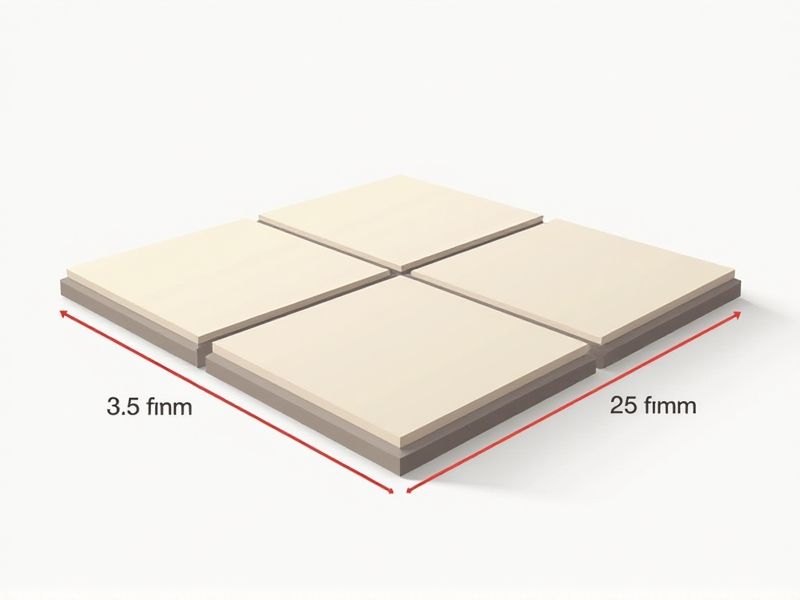
When selecting floor tiles, knowing the standard dimensions can help you plan your space and budget effectively. Common floor tile sizes include 12x12 inches (30x30 cm), 18x18 inches (45x45 cm), and 24x24 inches (60x60 cm), though rectangular options like 12x24 inches (30x60 cm) are also popular. Larger tiles can make a room look more spacious, while smaller tiles offer greater flexibility for intricate patterns. Choosing the right tile size ensures a balanced look and minimizes waste, making your flooring project smoother from start to finish.
Size Consistency
Size consistency is crucial in floor tile standards, influencing both aesthetic appeal and installation accuracy. High-quality tiles typically maintain a size variance of less than 1/8 inch, ensuring uniformity across the entire surface. This precision minimizes gaps and enhances the longevity of the installation, crucial for both residential and commercial applications. When selecting tiles, consider that consistent sizing not only affects visual alignment but also impacts maintenance and durability over time.
Thickness Level
The standard thickness of floor tiles typically ranges from 8 mm to 12 mm, with most residential tiles falling within this category. A thicker tile, often measuring up to 20 mm, is recommended for high-traffic areas as it enhances durability and resistance to wear and tear. When selecting your tiles, consider how thickness affects installation; thicker tiles may require additional adhesive and a solid substrate for proper support. Choosing the right thickness not only influences aesthetics but also impacts longevity, making it crucial for ensuring your flooring solution meets your needs effectively.
Edge Alignment
Edge alignment in floor tile installation is critical for achieving a visually appealing and durable surface. Precise alignment ensures that gaps between tiles are minimized, which can affect overall aesthetic and structural integrity. Typically, a standard tolerance of 1/16 inch or less is recommended for edge alignment during installation. By paying attention to these specifications, you can enhance the longevity of your tiled surfaces and maintain an attractive finish.
Surface Flatness
Surface flatness is a critical standard for floor tiles, ensuring a level and even installation. According to industry guidelines, the flatness tolerance for tiles typically ranges from 1/8 inch to 1/16 inch over a 10-foot span. This precision is essential to prevent issues such as lippage, where edges of adjacent tiles are uneven, which can compromise aesthetics and safety. For optimal results, consider using a leveling system during installation to achieve the required flatness.
Squareness
The standard for floor tile squareness is typically measured using a diagonal check, with a maximum permissible deviation of 1/8 inch over a length of 10 feet. Maintaining squareness is crucial to ensure proper alignment during installation, which enhances the overall aesthetics and durability of the flooring. You should verify that each tile's corners form perfect right angles, as this directly influences the ease of laying and the resulting visual uniformity. Adhering to these squareness standards not only improves the installation process but also contributes to the long-term performance of your tiled surfaces.
Rectangularity
Rectangularity in floor tiles is crucial for achieving a seamless and aesthetically pleasing installation. Industry standards specify that tiles should maintain a rectangular shape with a tolerance of +- 0.5% on the length and width dimensions. This precision ensures that each tile aligns properly, reducing the risk of gaps or uneven surfaces. By focusing on rectangularity, you enhance the overall durability and functionality of your flooring while elevating the design appeal of your space.
Wear Resistance
The standard for floor tile wear resistance is measured using the PEI rating, ranging from 1 to 5, where 1 indicates very light traffic and 5 signifies heavy commercial use. A PEI rating of 4 is ideal for residential spaces with moderate to heavy foot traffic, providing durability against scratches and abrasions. The abrasive resistance is further influenced by the tile's material, with porcelain tiles often achieving higher wear ratings compared to ceramic. In environments such as shopping malls or outdoor areas, choosing tiles with a PEI rating of 5 ensures long-lasting performance and minimal maintenance.
Slip Resistance
When selecting floor tiles, slip resistance is a crucial factor, with ratings often measured on the coefficient of friction (COF) scale. A minimum COF of 0.6 is recommended for wet areas, ensuring safety by reducing the likelihood of slips and falls. To enhance slip resistance, textured or matte finishes are often preferred, as they provide better grip compared to smooth surfaces. Investing in tiles with higher slip resistance not only prioritizes your safety but also complies with building codes and standards for commercial spaces.
Water Absorption
Water absorption is a crucial factor in determining the quality of floor tiles, significantly influencing their durability and performance. High-quality tiles generally have a water absorption rate of less than 0.5%, making them ideal for high-moisture areas like bathrooms or kitchens. In contrast, tiles with higher water absorption rates can lead to issues such as mold growth and structural damage, particularly in outdoor settings. When choosing tiles for your space, consider selecting those with low water absorption rates to enhance longevity and maintain aesthetic appeal.
Frost Resistance
Frost resistance is a crucial standard for floor tiles, especially in climates that experience significant temperature fluctuations. Tiles rated for frost resistance typically undergo rigorous testing, ensuring they can withstand freezing temperatures without cracking or deteriorating. Choosing frost-resistant tiles can enhance the longevity and durability of your flooring, with many options providing a lifespan of over 20 years when properly maintained. Look for tiles classified with a PEI rating of 4 or 5 for optimal frost resistance and performance, ensuring your outdoor spaces remain resilient throughout harsh weather conditions.
